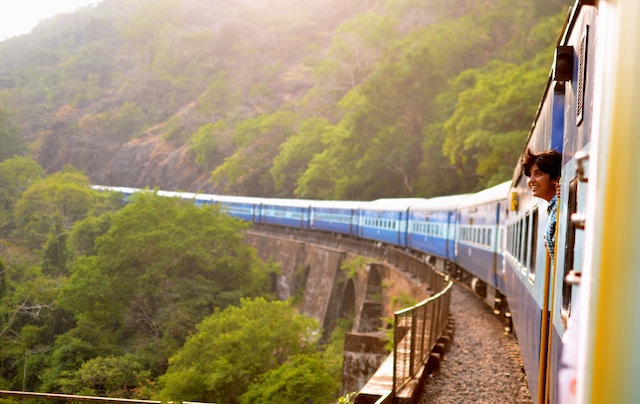How to Survive an Indian Train Ride

By my fifth week in India during my gap year, I had explored nearly every mode of transportation: the open-air sway atop an elephant, bustling bikes, crawling cars, bumpy buses, scorching hot foot paths, turbulence-ridden planes, and nauseating boat drifts. But the final mode was by far the most intense: public train.
Non-air conditioned. Six hours. 120 degrees of heat.
Embarking on this type of travel, namely India’s train system, involves many challenges. The first is getting to the train station via auto-rickshaw, a life-size tin can with open sides instead of doors that resembles the 1920’s predecessor to a Smart car. If I am lucky, my auto-rickshaw has one metal bar on one side, which I will cling to as I’m jostled about the cabin due to the driver’s zig-zagging traffic habits.
When I arrive at the train station, I must weave through crowds of locals to find the correct platform. It was in this environment that I learned: if I have a 12:15 train that leaves from platform 3, and there is currently a train at platform 3 at 12:14, that is not my train. Mine will be here in 15 “Indian minutes,” the locals tell me, which is often around 45 “American minutes.”
By my fifth week in India during my gap year, I had explored nearly every mode of transportation. Here’s what you need to know about Indian train rides.
My train looks like a brown or blue slug, speckled with bits of rust or an occasional graffiti mural. Embarking into the metal chamber, I can hardly fit my slender backpack through the aisles before me. In the heat, every fume that enters the car is there to stay and the floor is coated with rotting food, crumbs, and dirt. Cell phones play the latest Bollywood music for the whole cabin to enjoy.
I find myself surrounded on both sides by open cabins comprised of six boards, each akin to an extended seat in a child’s school bus with only a quarter-inch of cushioning. They fold off from the walls parallel to each other. The result is a life-sized filing cabinet for bodies. As the ceiling is only eight feet high, travelers must lie down or fold up other boards in order to sit up-right. My train ticket “entitles” me to one of these fold-down boards. However, after loading onto our fourth connecting train of the cross-country ride, I wonder why I even purchased the ticket because every time I enter the cabins, there is a local sleeping on my board.
It has been my experience that there are two ways to handle this cultural experience: negotiation or compliance.
Mine will be here in 15 “Indian minutes,” the locals tell me, which is often around 45 “American minutes.”
The first goes like this:
The Negotiation Method: Calmly approach the sleeping local. Politely pull on his sweat-drenched sleeve and indicate towards the board saying, “Excuse me, my seat.” He (or she) will open their eyes at once and get very upset by this.
The dialogue begins.
Local: (somewhat casually) “Noo, nooo.”
Visitor: (Pointing towards ticket). “My seat.”
Local: (His voice enlivens) “NO! No! No! My seat!”
Visitor: (Jabbing towards ticket) “No! My seat!”
Local: (Grumbling, realizes the visitor will not quit. He sits up.) “OK, OK” (pronounced tee-kay, with a right-ward head jab. He dismounts from the “bed.”)
This means I have prevailed. In celebration, I carefully lower myself onto the dirty plastic cover of the newly acquired board. In a few minutes, my next adversary arrives, tugs on my shirt and demands, “My seat!” After I go through the negotiation method steps again, he leaves to look for another tourist.
But soon, the fatigue of protecting my territory begins to wear me down and I resort to an alternative approach:
The Compliance Method: When traveling with a group of visitors, instead of having all the visitors in my group “negotiate” for our seats, we attempt to haggle for just one and allow the other seven locals to stay in our other two seats. The high density of un-ticketed travelers leaves little option but to pack the seats like sardines.
Pictures are taken of me at inches away from my face. Some phone-wielders are more subtle.
And then, the staring and picture-taking begins. Every attempt I make to look up is relinquished by the realization that almost an entire cabin of locals is looking at me. I am so stunned that I hardly know how to act. Bashful at first, my timid self-conduct eventually cedes into a feeling of abrasion. Have I done something wrong? Disrupted a cultural norm? In the tight quarters of the trains, there is no escape.
Then the camera phones are released. Pictures are taken of me at inches away from my face. Some phone-wielders are more subtle. They hold their arm out above where I am sitting to suggest that they are taking a picture of the cabin, but then briskly move the viewfinder down to my face before the shutter clicks. This continues on hour after hour, one after another, click after click. But that’s how it is everywhere I go-people stop what they’re doing to stare at my light skin tone, run up and fling their arms around me. I have even had babies shoved into my arms before they snapped a shot.
In search of distractions from the current milieu, I gaze out the barred open windows to see dry grasslands. Despite the high speed of movement, the whipping wind is hot. I spend the next few hours avoiding camera phones and counting down the minutes until I can leave the cabin and arrive in Agra, where the most geometrically-sound expression of love and remembrance awaited: The Taj Mahal.
How to Survive an Indian Train Ride photo by Unsplash.









It is really funny that you did not take an AC train to Agra. I have read many blogs of people from the west, i have interacted people from europe, I am really curious that they always have bad things to say about india, They have a notion that india is land of poverty, dirty people etc etc. You did not have any positive experiences during your visit?. Why do you people from west always want to see India as a 3rd world nation? I am sure your experiences would have been much better had you chose to spend money ( which again are peanuts considering american dollars) and not chose to travel in a 2nd class train.
Hi Monika, didn’t your train have AC cars? Also people don’t generally get to randomly grab your seat in regular non-AC reserved compartments.
You choose to travel in the worst conditions just so you can rant about it? Is that your idea of a travelogue?
Annoyed: Thanks very much for taking the time to read my article. I respect your interpretation of my piece in the same way I would expect readers to respect my interpretation of the experiences I had while in India. My trip to India was one of the most intense experiences I have ever had in my life. Through this article, I attempted to illustrate the pressures I felt so that those considering visiting would be exposed to another opinion before they departed. While you are entitled to your opinion, so too am I. Thank you for taking the time. –Monika
This is not the correct usage of onomatopoeia. Onomatopoeia refers to words that sound like the noise they describe. Such as, boom, plunk, fizzle, bang, pop etc. What you are describing is merely a misinterpretation of a distinguised culture. As an Indian, I find this article extremely offensive. Your tone is derragtory and arogant, assuming the higher superiority of what you would consider “the first world.” This gap year is an excuse to perpetuate your own cultural streotypes in a increasingly segregated world.
One note, please! “It’s ok” translate to “teekh hai” in Hindi. When I describe it above, I use the onomatopoeia of “tee-kay”, the way it sounded to me as a foreigner. Thanks! Monika Lutz